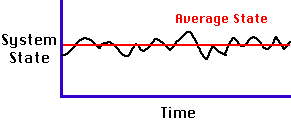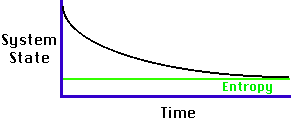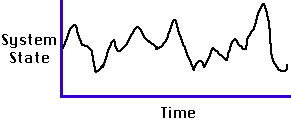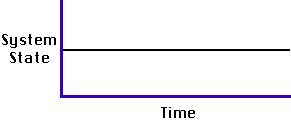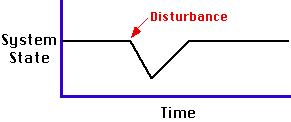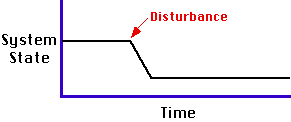Equilibrium
Equilibrium describes the average condition of a system, as measured through one of its elements or attributes, over a specific period of time. For the purposes of this online textbook, there are six types of equilibrium:
(1) Steady state equilibrium is an average condition of a system where the trajectory remains unchanged in time.
Figure 4f-1: Example of the state of a steady state equilibrium over time.
(2) Thermodynamic equilibrium describes a condition in a system where the distribution of mass and energy moves towards maximum entropy.
Figure 4f-2: Example of the state of a thermodynamic equilibrium over time.
(3) A dynamic equilibrium occurs when there are unrepeated average states through time.
Figure 4f-3: Example of the state of a dynamic equilibrium over time.
(4) Static equilibrium occurs where force and reaction are balanced and the properties of the system remain unchanged over time.
Figure 4f-4: Example of the state of a static equilibrium over time.
(5) In a stable equilibrium the system displays tendencies to return to the same equilibrium after disturbance.
Figure 4f-5: Example of the state of a stable equilibrium over time.
(6) In an unstable equilibrium the system returns to a new equilibrium after disturbance.
Figure 4f-6: Example of the state of an unstable equilibrium over time.
Feedbacks
In order for a system to maintain a steady state or average condition the system must possess the capacity for self-regulation. Self-regulation in many systems is controlled by negative feedback and positive feedback mechanisms. Negative-feedback mechanisms control the state of the system by dampening or reducing the size of the system's elements or attributes. Positive-feedback mechanisms feed or increase the size of one or more of the system's elements or attributes over time.
Interactions among living organisms, or between organisms and the abiotic environment typically involve both positive feedback and negative feedback responses. Feedback occurs when an organism's system state depends not only on some original stimulus but also on the results of its previous system state. Feedback can also involve the system state of non-living components in an ecosystem. A positive feedback causes a self-sustained change that increases the state of a system. Negative feedback causes the system to decease its state over time. The presence of both negative and positive feedback mechanisms in a system results in self-regulation.
To illustrate how these mechanisms work we can hypothetically examine the changes in aphid population growth in a mid-latitude climate in the following graphical models.

|
Figure 4f-7: Group of aphids feeding on the stem of a plant. |
Over the winter only a few aphids survive the cold winter temperatures and scarcity of food (Figure 4f-8). However, warmer temperatures in the spring cause plants to start growing, providing the aphids with food. The continually increasing abundance of food increases the fertility of individual aphids and the aphid population starts to expand exponentially. This situation is a positive feedback as abundant food resources cause increased reproduction and rapid population growth.
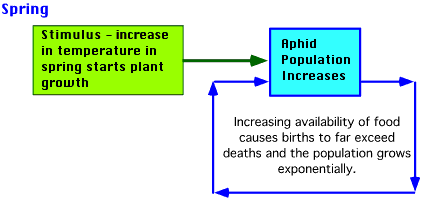
|
Figure 4f-8: Increase in food abundance causes a positive effect on the size of the aphid population. Births increase significantly and are much higher than deaths causing the population to expand. |
By late summer the supply of plants has reached its maximum (Figure 4f-9). As a result, the availability of food to the growing aphid population becomes less per individual as time proceeds. Less food means lower egg production and births begin to decline. When births reach the same level as deaths the aphid population stops growing and stabilizes. The population is becoming too large for the food supply. The size of the population relative to food supply produces a negative feedback as the fertility of aphids begins to decline.
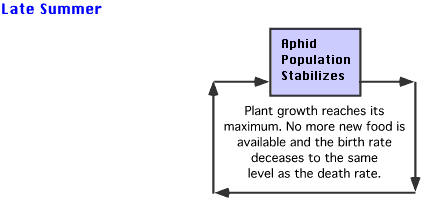
| Figure 4f-9: As the abundance of food levels off aphid reproduction slows down and deaths begin to increase. Population size of the aphids begins to level off. |
With the arrival of fall cooler temperatures reduce the supply of plants causing the large aphid population to be faced with further food scarcity (Figure 4f-10). The lack of food causes the aphid death rate to increase and the birth rate to decrease. The population begins to decline rapidly. The reduction of food caused by the cooler temperatures enhances the negative feedback that began in late summer.
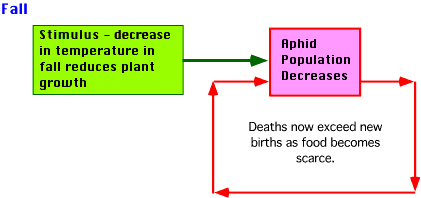
|
Figure 4f-10: The decrease in food abundance causes a negative effect on aphid population size. Deaths now exceed births and the population size of the aphids begins to decrease. |
